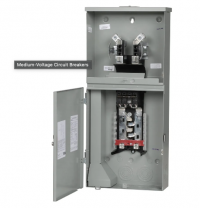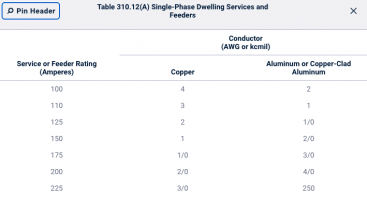jar546
CBO
In 2013 I built a home. I remember talking to the electrician about his choice of conductor sizes for the following scenario:
The service conductors were fed from the POCO pad-mounted transformer between houses in the development. The service conductors came directly to a 200A combination meter/service disconnect which is typical in Florida. Technically, the only service conductors were the lateral feed wires from the POCO to the combo pack seen below.
(click to enlarge)

Coming out of the bottom lugs of this 200A combo pack were 2/0 awg copper THWNs going to my MLO panel in the garage which acted as my main panel and provided 100% of the house load. So far so good, right? After all, Section 310.12(A) & Table allow 2/0 awg copper for a 200A service & feeders for an SFR. See Table below.
(click to enlarge)

Normally, a 200A service or feeder would require 3/0 awg copper conductors per NEC 200.16
Would it make any difference if the combo pack outside had a 60A circuit added to it for a pool panel?
Would NEC 310.12(A) make a difference? Personally, I don't think it matters if there is a shared load because the verbiage of NEC 310.12(A) concerning the sharing of the load would not apply because the 2/0 feeder to the MLO is just that, a feeder and not service conductors.
Do you agree?
The service conductors were fed from the POCO pad-mounted transformer between houses in the development. The service conductors came directly to a 200A combination meter/service disconnect which is typical in Florida. Technically, the only service conductors were the lateral feed wires from the POCO to the combo pack seen below.
(click to enlarge)

Coming out of the bottom lugs of this 200A combo pack were 2/0 awg copper THWNs going to my MLO panel in the garage which acted as my main panel and provided 100% of the house load. So far so good, right? After all, Section 310.12(A) & Table allow 2/0 awg copper for a 200A service & feeders for an SFR. See Table below.
(click to enlarge)

Normally, a 200A service or feeder would require 3/0 awg copper conductors per NEC 200.16
Would it make any difference if the combo pack outside had a 60A circuit added to it for a pool panel?
Would NEC 310.12(A) make a difference? Personally, I don't think it matters if there is a shared load because the verbiage of NEC 310.12(A) concerning the sharing of the load would not apply because the 2/0 feeder to the MLO is just that, a feeder and not service conductors.
Do you agree?
